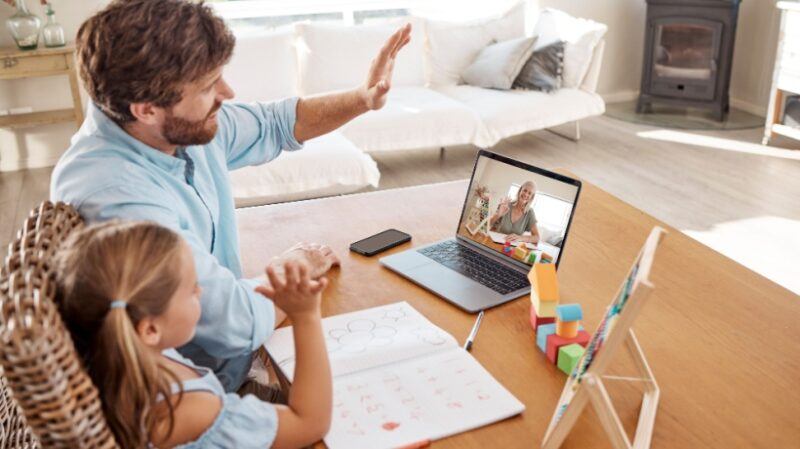
Building Partnerships Between Parents And Teachers
Building a partnership with your child’s teacher is the secret to your kid’s eLearning success. Since classrooms have gone virtual, communication between parents and teachers is more important than ever. So, you better get started building this partnership with your kid’s instructors. And why is it so important? Teachers get an insider look at your child’s academic journey and are often the first to spot any issues. If you’re not involved, you might miss out on vital information about your child’s learning experience.
How do you actually connect with the teachers? First, be positive. When you reach out, mention something specific about how they’ve helped your child or how engaging their lessons are. Be sure to be specific with your questions, too. Don’t just say, “My kid doesn’t perform well.” Instead, pinpoint the exact subject they struggle with and ask if the teacher has any tips or plans to resolve it. Most importantly, you have to really listen to what the teacher has to say. They know your child’s strengths and weaknesses. Take in their feedback and don’t hesitate to ask for clarification if you need it. Without further ado, let’s take a closer look at how parents and teachers can collaborate to support young learners in an online classroom.
6 Ways For Parents And Teachers To Offer Academic Support To Kids Learning Online
1. Communication Channels
Parents, teachers, and students all need to be part of the same conversation. This doesn’t refer to email exchanges once a semester; parents and teachers need regular updates. This includes updates on assignments, progress, and upcoming deadlines. The best you can do is set up a communication system, like weekly check-ins or syncing calendars. Teachers can also send weekly instructions for the upcoming schoolwork to parents so the latter can help their little ones. Communication means feedback, too, and feedback should flow both ways. Kids need to feel like they can ask questions or raise concerns with their parents and teachers. Parents should encourage their kids to speak up if they feel stuck, and teachers can create an environment where students feel safe asking questions.
2. Realistic Goals
Your little online learners need to work towards realistic goals to keep them going and reach success faster. Parents and teachers need to work together to set achievable goals within a reasonable timeframe. For instance, you can’t expect your kid to become a pro at science in one day. Instead, aim for them to feel more comfortable with chemistry by the end of the week. And don’t forget to adjust those goals based on how the student is actually doing. If your kid or student is struggling to finish their work, it’s not the time to add more to their plate. Most importantly, when they reach their goals, you should praise them. Every win, big or small, should be acknowledged, so cheer them up to motivate them to keep trying their best.
3. Utilize Technology
Kids have to use technology to learn online, and teachers and parents must use it to help them navigate the digital classroom. First, teachers should make good use of online libraries, eLearning authoring tools, and platforms where they can share resources. These will allow them to use a variety of learning materials, like educational apps, interactive elements, and others, that will make young learners glued to their lessons. Now, once teachers share these resources, parents should have a look and sit with their kids to explore them together. In eLearning, both parents and teachers should become a little more tech-savvy so that everything runs smoothly—from showing kids where to upload their work to solving Wi-Fi problems.
4. Monitor Progress
Online learning can be tricky, and paying attention to your kid’s academic progress is key to making sure your little learners aren’t slacking instead of finishing their homework. For parents, you don’t have to monitor them all the time, adding more pressure to their daily lives. Checking out how they’re doing in their virtual classes once in a while is enough. Set aside time to review assignments and grades. If something looks off, reach out to the teacher for insights. They’ll know how your child is really doing and what areas need improvement. Teachers should not just stick to grading assignments; they should actually give useful feedback. Share what’s going well and where the kid needs help to help both learners and parents. Keep in mind that there are online tools and platforms where teachers can upload data regarding young learners’ performance, allowing parents to access it at any time.
5. Encourage Active Learning
Keeping kids engaged during online learning isn’t an easy task, but don’t worry; we’ve got you covered. The first tip is to make good use of interactive activities. No one likes sitting in front of a screen for hours on end, so instead of just scrolling through endless online lectures, add a little fun. Parents suggest a collaborative project, like a virtual study group, where kids can actually talk to their peers and collaborate on a fun project. Teachers can assign small group work, while parents can jump in to help organize or even host virtual study sessions. Another engagement strategy is for teachers to add interactive elements to the courses. Teachers can engage young learners with real-life examples, asking them questions or using videos and memes.
6. Support Emotional Well-Being
School and studying are surely important, but if your child is feeling stressed, isolated, or overwhelmed, they can’t focus on their schoolwork. Parents should take a moment each day to check in with their kids. Ask them how school is going, how they feel, or how they are handling their workload. A quick emotional check-in can help you spot issues before they become serious problems. Plus, your kid will appreciate the chance to express their concerns or even just vent. Teachers play a role in that, too. Incorporate social-emotional learning (SEL) into your lessons. Whether it’s a simple mood check at the start of class or group activities where students can bond, SEL can help kids feel more connected and supported, which means they’ll actually want to participate.
Conclusion
As you and your child continue to adjust to the online classroom, remember that it’s a learning process for everyone. How much you’re involved plays a huge role in their success, but make sure you find the right balance—you don’t want to burden them. Keep communication flowing with teachers, check in regularly, and celebrate even the small wins. The key is to be encouraging, not controlling. This transition is challenging, but your child can thrive in the online classroom with your ongoing support and some great digital tools.

